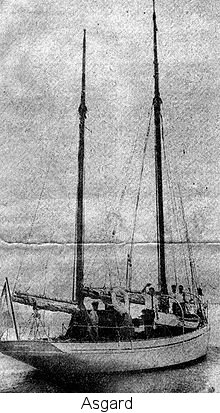Journal Volume 2 1995
The Landing of Arms and Ammunition at Kilcoole, County Wicklow by the Irish National Volunteers in 1914 (continued/3)
For reasons of security the entire plan was known only by Bulmar Hobson, Professor MacNeill, Sir Roger Casement and Erskine Childers. One final alteration was that the arms on the 'Kelpie' were to be transhipped to a steam yacht 'Chotah' which was then to land that consignment in Kilcoole.
Execution
At the end of May, the Home Rule Bill passed its third reading in the House of Commons, but it was not sent to the King to be signed into law. At the same time Darrell Figgis was sent to sent to Europe with Childers where in Hamburg they managed to purchase 1500 Model 1871/84 single shot 11mm Jaeger rifles which were surplus to the requirements of the German Army which had re-equipped with more modern weapons. Sellers Moritz Magnus did not have the weapons in Germany - they were stored in Antwerp - and Figgis had to travel there to select the best of them and then recruit local people to clean and prepare them for shipment to Germany. The purchase price was £1500 and this included 45 boxes of ammunition, each box containing 1000 rounds. Childers in the meantime had returned to start his end of the operation and at the end of June both the 'Kelpie' and 'Asgard' sailed from Ireland independently of each other and met at Cowes on July 9th where the final briefing on the operation took place.
Collection date for the cargo was Sunday July 12th off the Dutch coast and the next day, July 10th, both vessels sailed in order to make their meeting place on time. In the meantime Figgis has repacked the rifles and shipped them by rail to Germany without the Customs authorities being aware of what the consignment was. In Hamburg, Figgis chartered the tug ‘Gladiator’ and had to endure several hours of anxiety waiting for the ammunition to arrive which just came as they were about to cast off. Another hitch was the fact that the cargo had to be cleared by a Customs Official before departure but it was discovered that a pilot could exercise this function, so a sympathetic individual was obtained who did this and accepted a bribe from Figgis, who pretended to be a Mexican, and the cleared cargo, which all on board including the pilot knew to be arms and not as stated on the manifest, was now officially on the way from Germany to Ireland.
In the early hours of Sunday July 12th the ‘Gladiator’ sailed for the rendezvous point in the North Sea where Figgis had to wait the arrival of the two vessels. First to arrive was the ‘Kelpie’ and very quickly its consignment of 600 rifles and 20 boxes of ammunition were loaded and once this process was complete, the Kelpie’ departed immediately. Later the ‘Asgard’ arrived and it too was loaded with the balance of the consignment which amounted to 900 rifles and 25,000 rounds of ammunition - on the way to Ireland, 3000 rounds had to be dumped overboard due to a heavy seas which threatened to swamp the ‘Asgard’ which lay very low in the water due to the weight of her consignment.
In Ireland the Volunteers had been busy preparing for the landing day and spread so many rumours that the authorities were totally confused. The plan prepared by Childers allowed for 12 days sailing time to reach the rendezvous point in the Irish Sea where they were to meet with another vessel - the steam yacht ‘Chotah’ into which the arms on the Kelpie were to be loaded. The ‘Chotah’ was scheduled to bring these arms into Kilcoole on the night of Saturday/Sunday July 25th/26th as a prelude to the Howth operation on Sunday July 26th.


